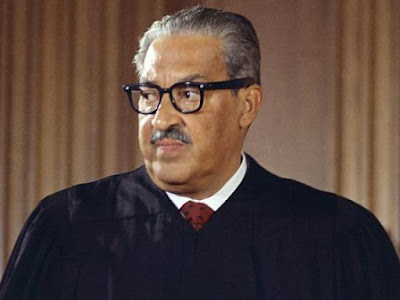The LuLac Edition #3585, August 31st, 2017
Marshall once bluntly described his legal philosophy as this: "You do what you think is right and let the law catch up", a statement which his conservative detractors argued was a sign of his embracement of judicial activism
Marshall served on the Court for the next 24 years, compiling a liberal record that included strong support for Constitutional protection of individual rights, especially the rights of criminal suspects against the government. His most frequent ally on the Court (the pair rarely voted at odds) was Justice William Brennan, who consistently joined him in supporting abortion rights and opposing the death penalty.
President John F. Kennedy appointed Marshall to the United States Court of Appeals for the Second Circuit in 1961 to a new seat created on May 19, 1961, by 75 Stat. 80. A group of Senators from the South, led by Mississippi's James Eastland, held up his confirmation, so he served for the first several months under a recess appointment. Marshall remained on that court until 1965, when President Lyndon B. Johnson appointed him to be the United States Solicitor General, the first African American to hold the office. As Solicitor General, he won 14 out of the 19 cases that he argued for the government.
His most famous legal case as a lawyer was Brown v. Board of Education of Topeka, 347 U.S. 483 (1954), the case in which the Supreme Court ruled that "separate but equal" public education, as established by Plessy v. Ferguson, was not applicable to public education because it could never be truly equal. In total, Marshall won 29 out of the 32 cases he argued before the Supreme Court.
Marshall retired from the Supreme Court in 1991 due to declining health. In his retirement press conference on June 28, 1991, he expressed his view that race should not be a factor in choosing his successor, and he denied circulating claims that he was retiring because of frustration or anger over the conservative direction in which the Court was heading." He was reportedly unhappy that it would fall to President George H. W. Bush to name his replacement. Bush nominated Clarence Thomas to replace Marshall.
Marshall died of heart failure at the National Naval Medical Center in Bethesda, Maryland, at 2:58 pm on January 24, 1993, at the age of 84. He is buried in Arlington National Cemetery. (LuLac, wikipedia.com)
She came to prominence in February 1981 when her engagement to Prince Charles was announced to the world.
Diana's wedding to the Prince of Wales took place at St Paul's Cathedral on 29 July 1981 and reached a global television audience of over 750 million people. During her marriage, Diana was Princess of Wales, Duchess of Cornwall, Duchess of Rothesay, and Countess of Chester. The marriage produced two sons, the princes William and Harry, who were then respectively second and third in the line of succession to the British throne. As Princess of Wales, Diana undertook royal duties on behalf of the Queen and represented her at functions overseas. She was celebrated for her charity work and for her support of the International Campaign to Ban Landmines. She was involved with dozens of charities including London's Great Ormond Street Hospital for children, of which she was president from 1989.
Diana remained the object of worldwide media scrutiny during and after her marriage, which ended in divorce on 28 August 1996. Media attention and public mourning were extensive after her death in a car crash in a Paris tunnel on 31 August 1997 and subsequent televised funeral.
Years later she is still a hot pop culture commodity. 2 decades after her death there is speculation about the way she died. On Clyde Lewis' program on the morning of the 20th anniversary, he had a guy on his show that claimed she was "assassinated".
Diana had the misfortune as well as a type of luxury in her untimely death at such a young age. Like JFK and Marilyn Monroe, she is frozen in time.
There were commemorations throughout London today.



2 Comments:
The American fascination with the descendants of a monarch, whose tyranny, many Americans gave their lives to escape, escapes me.
She gained money and fame by marrying into a family whose wealth and power was amassed by exploiting, plundering and destroying so many. A family who helped establish the slave trade which stole the freedom of many from Africa, the West Indies, etc. The House of Windsor is no better than the likes of Southern traitors or Columbus.
If you ever wonder why southerners, and so many in the north, hang on to confederate civil war leaders, all you need do is watch the linked movie. Racist jackholes wish it were a true documentary.
https://www.youtube.com/watch?v=exnwTWfFRM8
Post a Comment
<< Home